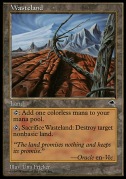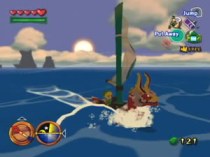Warning: From here on out, this article series will contain major spoilers throughout. If you haven’t finished The Wind Waker, read at your own risk!
~
In order for me to analyze the overworld of The Wind Waker, the origins of it need to be established.
“None remain who know,” the prologue says of the ancient land of Hyrule, the people of which could not fight back against Ganon’s onslaught of evil. From the mouth of King Daphnes Nohansen Hyrule himself at a later point in the game, we hear the following:
Once, long ago, this land of Hyrule was turned into a world of shadows by Ganon, who sought to obtain the power of the gods for his own evil ends. My power alone could not stop the fiend, and our only choice was to leave the fate of the kingdom in the hands of the gods... When the gods heard our pleas, they chose to seal away not only Ganon, but Hyrule itself... and so, with a torrential downpour of rains from the heavens... Our fair kingdom was soon buried beneath the waves, forgotten at the bottom of the ocean. Yet all was not lost. For the gods knew that to seal away the people with the kingdom would be to grant Ganon's wish for the destruction of the land. So, before the sealing of the kingdom, the gods chose those who would build a new country and commanded them to take refuge on the mountaintops. Those people were your ancestors. Hundreds of years have passed since then... So long as Ganondorf was not revived, Hyrule would remained below never waking from its slumber.
In short, Hyrule could do nothing but pray for divine intervention, which came in the form of severe flooding. The gods let the highest peaks of Hyrule become islands for the people to rebuild their lives upon, and the flood created a body of water known as The Great Sea.
~
The Wind Waker takes place in a post-apocalyptic wasteland.
The word “wasteland” commonly evokes images of areas that are desolate, bleak, and barren: places that are not used by anyone, and cannot foster any more life.
Wastelands, by definition, hold nothing for anyone or anything.
We have seen wastelands in other video games and forms of fiction. Often, we see post-apocalyptic wastelands. The apocalypses causing these wastelands to form vary from zombies to nuclear fallouts, but the wastelands typically have common themes: dystopian societies, war-torn environments, dark clouds and hellish-looking landscapes. Clearly, they hold nothing for the survivors of whatever catastrophe created it.
And clearly, one of these things is not like the other.
However, as we look closer at The Great Sea, we begin to notice how it falls under the definition of the word “wasteland,” and how it contrasts with the tone of the game – at least on the surface.
~
From a design perspective, The Great Sea is perfect in giving players a great big sandbox (or, in this case, maybe a swimming pool) to explore. While lacking the “do whatever” traits of a traditional sandbox game like Grand Theft Auto, the vast overworld gives The Wind Waker the element of open exploration that many adventure games implement. Sea monsters and cyclones populate the high seas, and with the acquirement of bombs come intense battles between you and AI ships. The Great Sea also contains 49 islands chock full of treasure, mini-dungeons, and hack-n’-slash style challenges. To argue that this overworld is a wasteland – that is, it holds absolutely nothing – is tough.
Likewise, as many players attest, the unrestricted exploration creates a spirit of adventure. It’s also hard to argue that The Great Sea is a wasteland when the atmosphere is so blatantly bright and buoyant. This adventurous, optimistic tone also works perfectly with the cel shaded setting. With the whimsical style, sailing on across the high seas reinforces all of these emotions. In general, there’s nothing necessarily depressing or bleak about sailing in The Wind Waker from a conceptual, emotional perspective.
But why? What is significant about having a wasteland evoke optimistic feelings through the art style and overall adventurous atmosphere? Does it serve a purpose at all in respect to the story or theme?
These questions will begin to be answered in my next section, where we’ll sail into even deeper waters and explore the overarching themes of The Wind Waker!


